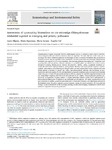Mostrar o rexistro simple do ítem
Assessment of cytotoxicity biomarkers on the microalga "Chlamydomonas reinhardtii" exposed to emerging and priority pollutants
| dc.contributor.author | Míguez López, Laura | |
| dc.contributor.author | Esperanza, Marta | |
| dc.contributor.author | Seoane, Marta | |
| dc.contributor.author | Cid, Ángeles | |
| dc.date.accessioned | 2020-12-14T16:45:24Z | |
| dc.date.available | 2020-12-14T16:45:24Z | |
| dc.date.issued | 2020-11-17 | |
| dc.identifier.citation | Míguez, L., Esperanza, M., Seoane, M., Cid, Á., 2021. Assessment of cytotoxicity biomarkers on the microalga Chlamydomonas reinhardtii exposed to emerging and priority pollutants. Ecotoxicol. Environ. Saf. 208. https://doi.org/10.1016/j.ecoenv.2020.111646 | es_ES |
| dc.identifier.issn | 0147-6513 | |
| dc.identifier.uri | http://hdl.handle.net/2183/26934 | |
| dc.description.abstract | [Abstract] Contamination of aquatic ecosystems linked to anthropogenic activity is currently a major concern; therefore, ecotoxicological studies are needed to assess its effect on organisms. The main objective of this study was to investigate the effects of different pollutants on microalgae in search of sensitive biomarkers that can promote a common cytotoxic response regardless of the contaminant. Cultures of the freshwater microalga Chlamydomonas reinhardtii were exposed for 24 h to four chemicals, three emerging pollutants (benzophenone-3, bisphenol A and oxytetracycline) and one priority substance (atrazine). A cytometric panel was carried out to assess toxicity biomarkers including cellular growth, inherent cell properties, viability, vitality, cytoplasmic membrane potential and ROS levels. Lipid peroxidation, photosynthetic efficiency and transcriptional responses of photosynthesis- and oxidative stress-related genes using RT-qPCR were also studied. Some toxicity responses showed a similar pattern; a decrease in growth rate, vitality and photosynthetic efficiency and an increase in autofluorescence and in the number of cells with depolarised cytoplasmic membrane and were found for all chemicals tested. However, ATZ and OTC provoked a decrease in cell size, whereas BP-3 and BPA caused an increase in cell size, intracellular complexity and ROS levels and a decrease in cell viability. Assayed pollutants generally promoted an overexpression of genes related to cellular antioxidant defence system and a subexpression of photosynthesis-related genes. In addition to the traditional growth endpoint, cell vitality, autofluorescence and gene expression of catalase, glutathione peroxidase and Fe-superoxide dismutase were significantly affected for all chemicals tested, showing a common cytotoxic response. Among the tested substances, BP-3 provoked the strongest cytotoxic alterations on this microalga, pointing out that some emerging contaminants could be more harmful to organisms than priority pollutants. | es_ES |
| dc.description.sponsorship | Ministerio de Economía, Industria y Competitividad; CTM 2017- 88668-R | es_ES |
| dc.language.iso | eng | es_ES |
| dc.publisher | Elsevier | es_ES |
| dc.relation.uri | https://doi.org/10.1016/j.ecoenv.2020.111646 | es_ES |
| dc.rights | Atribución 3.0 España | es_ES |
| dc.rights.uri | http://creativecommons.org/licenses/by/3.0/es/ | * |
| dc.subject | Microalga | es_ES |
| dc.subject | Emerging pollutants | es_ES |
| dc.subject | Priority pollutants | es_ES |
| dc.subject | Cytotoxicity | es_ES |
| dc.subject | Biomarkers | es_ES |
| dc.title | Assessment of cytotoxicity biomarkers on the microalga "Chlamydomonas reinhardtii" exposed to emerging and priority pollutants | es_ES |
| dc.type | info:eu-repo/semantics/article | es_ES |
| dc.rights.access | info:eu-repo/semantics/openAccess | es_ES |
| UDC.journalTitle | Ecotoxicology and Environmental Safety | es_ES |
| UDC.volume | 208 | es_ES |
| UDC.startPage | 111646 | es_ES |






